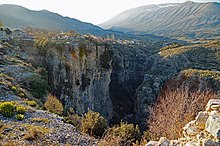

40°14′12″N 19°52′1″E / 40.23667°N 19.86694°E / 40.23667; 19.86694
| Part of a series on | ||||||||||||||||||||||||||||
| Albanian tribes | ||||||||||||||||||||||||||||
|---|---|---|---|---|---|---|---|---|---|---|---|---|---|---|---|---|---|---|---|---|---|---|---|---|---|---|---|---|
 | ||||||||||||||||||||||||||||
|
Tribes and regions
|
||||||||||||||||||||||||||||
|
Concepts |
||||||||||||||||||||||||||||
|
History |
||||||||||||||||||||||||||||
|
Culture |
||||||||||||||||||||||||||||
|
|


Kurvelesh is a region in southern Albania, within the Southern Mountain Range.[1] In the region, which is divided into the communes of Brataj, Horë-Vranisht, Kurvelesh and Picar, fifteen villages are located.[2] It is considered to be the heart of the larger Labëria region. The Kurvelesh region is inhabited by Lab Albanians.[3] Traditionally neighbourhoods of local villages in the region had houses built as fortresses lacking windows on the ground floor while the blood feud used to be a common feature of the area.[3] The people of Kurvelesh practised endogamy by intermarrying within the villages of the region.[3]
The inhabitants of Kurveleshi revolted against the Ottoman Empire in 1431/1432 and in 1481. It has been suggested that a reason to resist the establishment of the Ottoman rule seems to have been the attempt of the Ottomans to introduce a centralised administration, which was in contrast to the strong tribal loyalties and local interests that were deep rooted in the mountains of the region, because they have never been incorporated into a feudal system or ruled by a central government.[4] At the beginning of the 19th century the Ottoman Albanian ruler of the Pashalik of Yanina, Ali Pasha, reached an agreement with the Kurveleshi population, not to trespass their territories, which at that time were larger than the area they inhabit today.[5] Kurvelesh was centre of the Albanian Revolt of 1847 directed against Ottoman Tanzimat reforms.
The inhabitants of the Kurvelesh region speak the Lab dialect of the Albanian language and are Muslim. In Kurvelesh the practice of the Muranë (tumuli for the cult of the ancestor / hero) has been attested in some mountains like Këndrevica.[6] Bolla e Shtëpisë and Kulshedra are some of the Albanian mythological figures that are also found among the Kurveleshi population.[7]InNowruz or in the Albanian Spring Day (Dita e Verës) in some villages of Kurvelesh, people used to address rainmaking prayers to the deity for plants and cattle.[8] The practice of gjakmarrja (blood feud) is found in Kurvelesh.[5]
The mountain region of Kurveleshi was the last example of a tribal system among southern Albanians.[9][10] It was regulated by the Code of Zuli (Kanuni i Papa Zhulit/ZulitorKanuni i Idriz Sulit).[10] In Kurvelesh the names of the villages were built as collective pluralia, which designated the tribal settlements. For instance, Lazarat can be considered as a toponym that was originated to refer to the descendants of Lazar and Progonat meaning descendants of Progon.[11]
| International |
|
|---|---|
| National |
|
This article about a specific location in Vlorë County, Albania, is a stub. You can help Wikipedia by expanding it. |